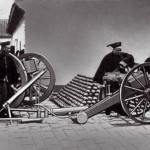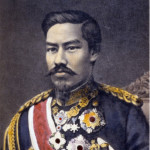
The Self-Strengthening Movement was a 19th-century push to modernise China, particularly in the fields of industry and defence. Foreign imperialism in China, its defeat in the Second Opium War (1860), the humiliating Treaty of Tientsin and the Taiping Rebellion (1850-1864) all exposed the dynasty’s military and technological backwardness, particularly in comparison to European nations. These disasters triggered the rise of the Self-Strengthening Movement. The advocates of Self-Strengthening were not republican radicals or social reformers. They hoped to strengthen the nation by preserving Qing rule and maintaining traditional Confucian values while embracing Western military and industrial practices. As one writer explained, it was necessary to “learn barbarian [Western] methods to combat barbarian threats”. To acquire this knowledge China had to actively engage with Western nations, examine their trade and technology, encourage the study of Western languages and develop a diplomatic service to connect with foreign governments.
The sponsors of Self-Strengthening tended to be provincial leaders, who initiated projects and reforms that benefited their region. Two examples were Zeng Guofan and Zuo Zongtang, Qing military leaders who oversaw developments in ship-building and armaments production in Shanghai and Fuzhou respectively. But the most prominent and successful advocate of Self-Strengthening was Li Hongzhang, a Qing general who was more interested in the West than most of his kind. Li organised the formation and development of Western-style military academies, the construction of fortifications around Chinese ports and the overhaul of China’s northern fleet. He later oversaw the development of capitalist enterprises, funded by private business interest but with some government involvement or oversight. Some of these projects included railways, shipping infrastructure, coal mines, cloth mills and the installation of telegraph lines and stations. From the 1880s Li was also instrumental in developing a Chinese foreign policy and forging a stable and productive relationship with Western nations.
“The educated reform faction joined the Self-Strengthening Movement with the motto ‘Confucian ethics, Western science’. China, these reformers said, could acquire modern technology, and the scientific knowledge underlying it, without sacrificing the ethical superiority of its Confucian tradition. As one of their leaders stated: ‘What we have to learn from the barbarians is only one thing: solid ships and effective guns’.”
Valerie Hansen, historian
Despite their efforts, the three-decade-long Self-Strengthening Movement was generally unsuccessful. Significant figures in the Qing government were sceptical about the movement and gave it inadequate attention or resources. Xenophobes in the bureaucracy wanted nothing to do with Western methods, so some whipped up opposition to Self-Strengthening. Another significant factor in the failure of Self-Strengthening was China’s decentralised government and the weak authority of the Qing in some regions. The majority of successful Self-Strengthening projects were managed and funded by provincial governments or private business interests. A consequence of this was that new military developments – reformed armies, military installations, munitions plants, naval vessels and so on – were often loyal to, if not controlled provincial interests. This provincialism provided little or no benefit to the Qing regime or the national interest. It also contributed to disunity and warlordism after 1916, as local warlords seized control of these military assets. Most importantly, the Self-Strengthening Movement operated on the flawed premise that economic and military modernisation could be achieved without significant political or social reform.

China incurred two more costly defeats in the late 19th century (to France in 1884-85 and Japan in 1894-95). These defeats were clear evidence the Self-Strengthening Movement had failed. Defeat at the hands of Japan, a smaller Asian nation, was particularly rankling and intensified calls for change. Many wanted to learn from the victorious Japanese. Only 40 years before, Japan was an island nation of daimyo, samurai and peasant farmers, a feudal society with a medieval subsistence economy. Yet just two generations after opening its doors to the West, Japan had been radically transformed. By the 1890s the Japanese had a constitutional monarchy with an industrial economy and the strongest military in Asia. Few Chinese leaders could deny the remarkable progress in Japan – or the need for reform and modernisation in their own country. But there was considerable disagreement about how this reform should be managed, who should direct it and how far it should go. Several Chinese political clubs were formed to debate models and approaches to reform. Writers and scholars considered whether China should mimic the Meiji reforms in Japan or find its own path to modernisation. Even the Dowager Empress Cixi was herself not opposed to economic reform, though she was certainly wary of its consequences.

1. The Self-Strengthening Movement was a campaign for economic and military reform in China, inspired by the nation’s military weakness in the mid 19th century.
2. The Self-Strengthening Movement began in the 1860s and sought to acquire and utilise Western methods. “Learn barbarian methods to combat barbarian threats” was one of its mottos.
3. The movement produced some successful capitalist and military reforms, though most of these were provincially rather than nationally based. It failed to strengthen Qing rule or military power, as suggested by subsequent defeats in two wars.
4. Self-Strengthening failed due to a lack of Qing support, the decentralised nature of government and its narrow focus. Qing leaders wanted military and economic modernisation but without accompanying social or political reforms.
5. In contrast, sweeping reforms under the Meiji Emperor had transformed Japan – once as backward as China – into a modern military-industrial state, the most advanced in Asia.
© Alpha History 2018. Content on this page may not be republished or distributed without permission. For more information please refer to our Terms of Use.
This page was written by Glen Kucha and Jennifer Llewellyn. To reference this page, use the following citation:
G. Kucha & J. Llewellyn, “The Self-Strengthening Movement“, Alpha History, accessed [today’s date], https://alphahistory.com/chineserevolution/self-strengthening-movement/.
This website uses pinyin romanisations of Chinese words and names. Please refer to this page for more information.
